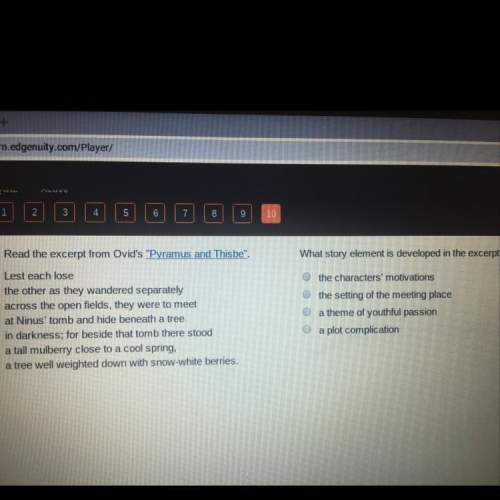
English, 28.07.2019 16:00 miguel454545
When you use spatial organization, you present details a. in the order they happened. b. according to their relationship in space. c. from the most important to the least important.

Answers: 2


Another question on English

English, 21.06.2019 15:30
Ead the passage from "marriage is a private affair” by chinua achebe. "i shall never see her,” was the reply. from that night the father scarcely spoke to his son. he did not, however, cease hoping that he would realize how serious was the danger he was heading for. day and night he put him in his prayers. nnaemeka, for his own part, was very deeply affected by his father’s grief. but he kept hoping that it would pass away. if it had occurred to him that never in the history of his people had a man married a woman who spoke a different tongue, he might have been less optimistic. "it has never been heard,” was the verdict of an old man speaking a few weeks later. in that short sentence he spoke for all of his people. this man had come with others to commiserate with okeke when news went round about his son’s behaviour. by that time the son had gone back to lagos. "it has never been heard,” said the old man again with a sad shake of his head. "what did our lord say? ” asked another gentleman. "sons shall rise against their fathers; it is there in the holy book.” "it is the beginning of the end,” said another. how does this passage reinforce the traditional social hierarchy? the older men in the village tell okeke that he should respect nnaemeka’s decision. the older men in the village console nnaemeka about okeke’s attitude toward his choices. the older men in the village commiserate with okeke regarding nnaemeka’s decision to disobey him. the older men in the village think that nnaemeka should be optimistic that okeke will accept his decision.
Answers: 1

English, 21.06.2019 16:40
Read this excerpt from "ain't i a woman? " by sojoumer truth in which three sentences does she make an emotional appeal to the audience by talking about her personal hardships? well, children, where there is so much racket there must be something out of kilter. {i think that 'twixt the negroes of the south and the women at the north, all talking about rights, the white men will be in a fix pretty soon.} but what's all this here talking about? {that man over there says that women need to be into carriages, and lifted over ditches, and to have the best place everywhere. nobody ever me into carriages, or over mud puddles, or gives me any best place} and ain't i a woman? look at me! look at my arm! {i have ploughed and planted, and gathered into bars, and no man could head me! } and ain't i a woman? i could work as much and eat as much as a man - when i could get it - and bear the lash as well! and ain't i a woman? {i have borne thirteen children, and seen most all sold off to slavery, and when i cried out with my mother's grief, none but jesus heard me! } and ain't i a woman? {then they talk about this thing in the head, what's this they call it? [member of audience whispers, "intellect") that's it, honey.} what's that got to do with women's rights or negroes' rights? if my cup won't hold but a pint, and yours holds a quart, wouldn't you be mean not to let me have my little half measure full?
Answers: 3

English, 21.06.2019 23:30
4. at the conclusion of frankenstein, robert walton has an encounter with the monster, who arrives after victor frankenstein has died. perhaps surprisingly, the monster mourns his creator and expresses remorse over the fate that victor suffered. the monster pledges to destroy himself and then departs, disappearing as he goes further north. how does the monster’s behavior and attitude in this part of the novel affect the way readers view him? is he sympathetic? is he more hateful because it is only after victor has died that he relents? how does the change in the monster fit with the theme of duality in the novel?
Answers: 1

English, 22.06.2019 00:30
The tone of a story is the author's attitude toward the subject. provide two examples that support the conclusion that the tone of this story is ironic.
Answers: 3
You know the right answer?
When you use spatial organization, you present details a. in the order they happened. b. according...
Questions








Mathematics, 30.07.2019 18:10















